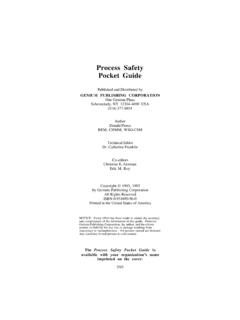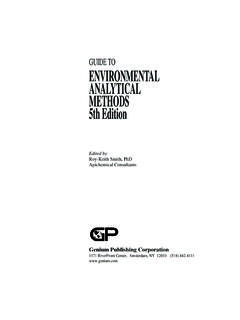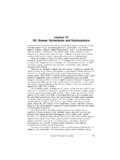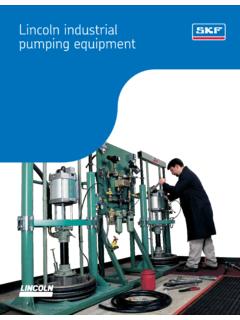Transcription of Laboratory Contamination - Genium Publishing …
1 Genium Publishing CorporationCHAPTER 9 Laboratory ContaminationLaboratory Contamination is defined as the inadvertent addition of target analytes tosamples during the sample collection, transportation and analysis process. Just like theadage that the best place to catch a disease is in the hospital, the best place to find anenvironmental pollutant is in an analytical Laboratory . Contamination manifests itself inthe detected presence of target analytes in the sample that are in greater amounts thanthey are in the native source of the sample. In 1994 EPA announced that all the ambientmonitoring data that had been collected for over 30 years in more or less pristine sitesin an ongoing effort to define the natural background levels of heavy metals wasunreliable due to Contamination in sample collection and analysis. Oceanographershave discovered in the last 10 years that historically determined ambient ocean metalslevels are heavily biased due to the presence of the metal hull of the ship used for theresearch.
2 Although a majority of the attention has been directed toward metals, Contamination issues are not limited to the metals in inorganic elevated amounts of target analyte in a particular sample above thatpresent in the sample source is the most visible manifestation of laboratorycontamination, but there are other effects that in many ways are more serious. Chiefamong these is the question of advertised detection limits of the Laboratory . Based onmany years as a quality assurance manager in an environmental Laboratory I can statewithout any reservation that unless a Laboratory has a specially constructed clean roomand it is maintained and monitored under the strictest protocols, detection limits lessthan 20 ug/L for copper, aluminum, zinc, iron, and nickel, and less than 50 ug/L forsodium, calcium, magnesium, and potassium are unachievable. The problem is not withthe instruments, rather its is due solely to Contamination . An example of contaminationand one effect on realistic detection levels is illustrated in the calibration plot presentedin Figure laboratories have Contamination problems, and these problems are unavoidableand largely insurmountable without significant investment in construction andmaintenance of clean room facilities.
3 Clean rooms are designed1 to minimizelaboratory Contamination in metals single most significant item that contributes to inorganic Contamination is all persons at one time in their life or another have had occasion to sit watchingdust motes floating in the air through a sunbeam while their thoughts wander off intoeternity. When I was young I imagined that I was seeing atoms and molecules. What Iwas actually seeing was only the very large dust particles, not even remotely close insize to the atomic or molecular scale. Many particles, such as those that composesmokes, are much too small to be seen as individual particles even in a are composed of both inorganic and organic materials. Some dust particlesare formed from the slow weathering of solid objects while others are created fromactive biological or chemical processes upon materials. One chemical process thatcontributes substantial quantities of dust to the air is combustion. Air-suspendedparticles range in water content from very dry particles to microdroplets of water thatform around a solid nucleus.
4 Fogs and clouds are the most commonly encountered form 1 EPA Office of Water, 1995. Guidance on Establishing Trace Metal Clean Rooms in ExistingFacilities. USEPA INTERPRETATION OF INORGANIC DATAG enium Publishing Corporationof the microdroplet particle. Particles with a high water content tend to stick to solidobjects easier than dry particles. Dust particles are almost always heavier than air, but itis actually the ratio of weight to volume (density) and physical size that determinestransport ability through the air. Dense dust particles will quickly settle out from the airand coat everything. Less dense particles can be suspended in the air for very longperiods of major intent of the clean room is to minimize metal-containing dust. This isprimarily achieved by filtration of the air entering the room through high efficiencyparticle attenuation (HEPA) filters which remove all categories of particulates. Theclean room is operated under positive pressure so that the flow of air is always out ofthe room, and the only air entering the room must pass through the HEPA second, although also important concern, is to minimize the creation of metal-containing particulates within the clean room.
5 This is achieved by elimination of asmany metallic objects within the room as possible. Trace metals laboratories utilizestrong, corrosive acids for sample preparation, and invariably these acids produce acidvapors that hasten the corrosion of any metal items. Thus structural and accessory itemsin the room such as the walls, floor, ceiling, ducting, benches, stools, hoods, sinks,doors, miscellaneous Laboratory equipment, reagent containers, etc., are made ofplastics. This includes faucets and plumbing. Items that must contain metals such as theelectrical and lighting system and Laboratory devices such as balances and hot plates areisolated from the room as much as possible or coated/encased with plastics (epoxypaint or silicone glue) to minimize exposed metal surfaces and clothing that technicians wear can serve as a transport mechanism for metal-containing particulates from one part of the Laboratory to another. Thus provisions mustbe made to eliminate this source of Contamination by requiring clothing to be changedas technicians enter and exit the clean room.
6 In the most successful and elaboratedesigns, a clean room actually consists of a series of dead-space connected rooms thatprogress in cleanliness from the regular parts of the Laboratory to the clean areasinvolved with sample preparation, sample container preparation, and air flowRegular Laboratory Change room Instrument room Container prep room Sample prep roomFigure 9-1. Schematic of trace metals clean room simple possession of a clean room facility does not by itself resolve thecontamination issue. Operational procedures must be used that actively minimize thelevels of Contamination within the area. Access to the clean room is limited to thosepersons who are well versed and constantly aware of clean that are used in sample preparation and analysis must be the highestquality available. Acids must be free from trace metal Contamination . The most suitableacids are prepared by sub-boiling distillation. Acids purified by this technique arecommercially available; however, the apparatus to perform this purification isreasonably priced and over the long-run will pay for 9 9-3 Genium Publishing CorporationA significant area that presents a potential for Contamination is the presence anduse of quality control standards for matrix and blank spiking in the sample preparationroom.
7 Extreme care must be exercised in keeping the standards and pipettes used forspiking separated from the analytical samples. It only takes one small drop of a spikesolution to contaminate a laboratories have developed a phobia about the use of glassware based onthe belief that glass interacts with the metals in solution. The interaction is believed tobe an ion exchange phenomenon with heavy metals in solution being exchanged for thelight metals in the glassware. Further this phobia has led to the belief that plastics,particularly fluorocarbon plastics, are the best overall replacement for all uses of glassin the metals any qualification, there is no plastic volume measurement system, such asa micropipettor with disposable plastic tips or a plastic volumetric flask, that is asreliable as the Class A volumetric glassware. Micropipettors can be adjusted to delivervolumes of liquids with the accuracy of Class A glassware; however, they are high-maintenance devices, requiring complete disassembly and lubrication followed byrecalibration about every three weeks.
8 They should be checked for accuracy at leastweekly to assure that the correct volume is being delivered. The first symptom that amicropipettor needs maintenance is loss of precision in volume delivery due to leakagearound the plunger. Further, each new lot number of disposable tips must be checked toinsure that they are free from , it is true that elemental standard solutions should be stored in eitherfluorocarbon or high density polyethylene bottles rather than glass because ionexchange can occur during the sometimes lengthy storage times. Plastic containers,except for the fluorocarbon polymers, are also considerably cheaper than glass, and canbe treated as disposable. However storage instability is no reason to avoid using acid-washed Class A volumetric glassware for accurate preparation of the solutions. Aplastic volumetric flask is only calibrated to Class B tolerances and, further, is muchmore susceptible to thermal contraction and expansion than is a glass flask. The contacttime with the glassware is generally less than 2 or 3 minutes, which is insufficient timeto alter the composition of the solution.
9 A glass volumetric flask is not a storagecontainer. After accurate volume adjustment is made, the solution is immediatelytransferred to a plastic storage bottles are not suitable for storage of mercury standards, samples, orsolutions as has been demonstrated many times. Mercury is easily reduced to theelemental state even in the presence of nitric acid. In the zero-valent state mercury isable to dissolve into the walls of the plastic containers. Even more significant, mercuryin cationic form is not inert to organics. There are numerous examples where mercuryadds to unsaturated organic molecules in the well-characterized oxymercurationreaction to form a covalent carbon-mercury (NO3)2 + H2O + R2C = CR2 --> O3 NHg-C(R2)-C(R2)OH + HNO3 Mercuric acetate is normally the preferred reagent for this reaction when it is performedin organic synthesis; however, mercuric nitrate is known to be even more active thanthe acetate. Most plastics, such as the polyfluorocarbons and the polyethylenes, areformed from monomers with a double bond, tetrafluoroethylene and ethylene, and thereare always residual double bonds in the plastic, enough to completely deplete a lowconcentration standard or sample of mercury.
10 Mercury standards, samples, andsolutions must be stored and manipulated in laboratories have resorted to using digestion containers made of inertplastics, such as the polyfluorocarbons, in an effort to avoid Contamination not initially contaminated, polyfluorocarbon containers can become metal-9-4 INTERPRETATION OF INORGANIC DATAG enium Publishing Corporationcontaminated with use2. A cleaning technique that includes a weekly soaking with astrong chelating agent such as EDTA can satisfactorily correct this are not the only inorganic analytes that are subject to laboratorycontamination. The common anions nitrate, phosphate, sulfate, and chloride areubiquitous in the environment and in the Laboratory . Ammonia, being a gas at roomtemperature, tends to permeate the air of the Laboratory whenever a bottle of reagentammonia is opened, and can contaminate both standards and samples. Laboratorypractices that help to lessen the Contamination problem are the use of dedicatedglassware and reagents for each procedure and performing the individual analyses inisolated sections of the Laboratory rather than out in large common work the following suggestion may seem to be anathema to Laboratory managerswho tend to rigorously segregate organic from inorganic analysis, in fact, a judiciousmixing of organic and inorganic work areas can help reduce Laboratory contaminationproblems.










